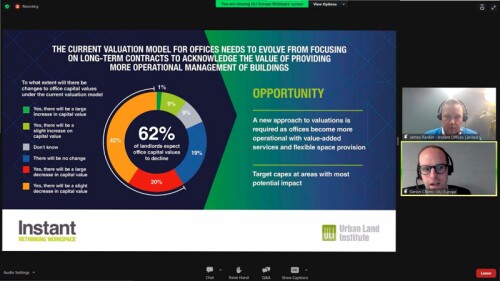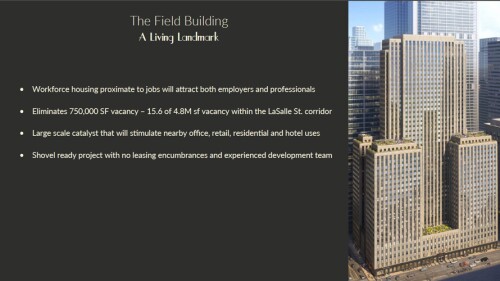The former Fannie Mae headquarters in Washington, D.C., was recently transformed into 1.2 million square feet (111,000 sq m) of residential, retail, and office space known as City Ridge. It was a huge investment for D.C.-based Roadside Development: the company paid $86 million to purchase the property seven years ago, along with partner North America Sekisui House, Japan’s biggest homebuilder, Roadside chief investment officer Patricia Earnest said at a ULI Spring Meeting session.
Keenly aware of the interest such a high-profile project would attract, Roadside embarked on community engagement efforts—a key element when retrofitting historic buildings, experts agree. However, to be successful at such an endeavor involves more than simply lecturing to community members about design plans, Earnest said.
“It’s not just, we’re going to come talk to you about our project,” she said. “We’re going to talk to you about how does the access work for [Glover Archbold Park], and what are we doing to help rehab where the erosion is in the park. What kind of connectivity are we going to give to the Metro or to our properties on either side, including McLean Gardens, which has a lot of expensive condo product. The company comes from that place. A lot of it is the retail mentality, too, because you have to be community oriented to draw people to you.”
Roadside held more than 300 neighborhood meetings to ensure it was communicating in a “thoughtful, curious way that would make the neighborhood happy and engaged,” Earnest said of the project, which has LEED v4 Neighborhood Development Gold certification—the first in the city able to claim that status and the second nationwide to achieve it.
Hyon Rah, head of sustainability for U.S. real estate at DWS Group’s D.C. office and moderator of the session, titled “Retrofitting Historic Buildings to Achieve Social, Economic, and Environmental Sustainability,” agreed that input from neighbors should be the focus of any such project. She also stressed how vital community engagement is in the development process, especially early on.
“In addition to financial misconceptions and challenges involved with historic retrofits, another part that’s challenging to navigate is community engagement because there are always different interests—a lot of different groups you have to engage,” Rah said. “Really, if you do not have the buy-in from people that are local, that are involved and have influence, you really cannot get anything moving, even if you have the money.”
Wooing Stakeholders
Special attention was required for the development of Zibi, a master-planned development under construction in Ottawa on 34 acres (14 ha) of waterfront property. The project is relying heavily on feedback from the community, including consulting with Indigenous people, according to Mark Thompson Branch, founding partner and senior conservation architect at Ottawa-based Trace Architectures.
Real estate company Dream Unlimited traveled to Indigenous communities to discuss parkland and open space and to ascertain what it would take for the communities to support development of the site, which is sacred to First Nations people.
“This was the first time that a developer in Canada, and possibly in North America, had an active engagement series of negotiations and discussions with the elders of the Algonquin community,” Branch said. “They went for much more than just window dressing.”
The effort resulted in creation of park space and the addition of views, he said. He added that agreements have also been reached to ensure that Indigenous people will be able to secure some of the local jobs. The developer is planning to preserve some of the historic infrastructure and redevelop some of the buildings on the site, as well.
“The community was absolutely interested and wanted a say,” Branch said. “They had the largest community engagement program I’ve ever seen in 35 years in the industry. It’s not public consultation, which is just like, ‘We heard you. We’ll figure something out.’ It’s actual engagement where you’re holding workshops; you’re bringing things together in a way that actually influences the designers.”
Incentivizing Community Engagement
Many agree it is a good thing to have discussions with neighbors. However, developers concede there are also incentives.
“In this project, we still have 300,000 square feet [28,000 sq m] of retail and commercial, which we want to be successful,” Earnest said. “So, it’s not like you don’t have motivation to do these things. But I think if you do them effectively, you’re trying to create that win/win.”
Roadside’s project is also preserving 100,000 square feet (9,300 sq m) of building space. It offers 8 percent of its nearly 700 apartments as affordable housing.
“I think it’s really important to be providing a property and providing a community asset that kind of hits the social, economic, and environmental aspects,” Earnest said.
Heather Slack, consultant and founder and president of Kristoffy Capital, explained that some retrofitting projects do not need to use historic tax credits, but that is not true in other parts of the country.
“In the Midwest and the Rust Belt, we’re not as fortunate,” Slack said. “We have to layer many incentives and build a really tall capital stack to make these projects work.”




